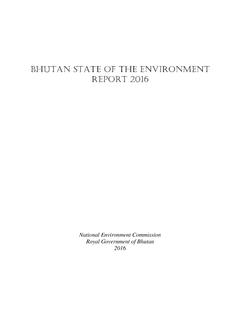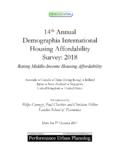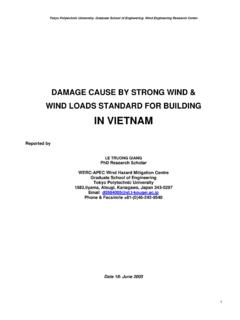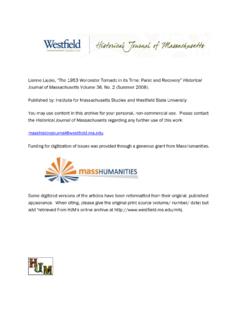Transcription of Environmental Education infused - National Council Of ...
1 Environmental Education as infused in NCERT Syllabus For Classes I to XII As Per NCF 2005 Department of Education in Science and Mathematics National Council of Educational Research and Training Sri Aurobindo Marg, New Delhi - 110016 1 INTRODUCTION The present status of Environmental Education (EE) in schools had its genesis in the National Policy of Education (NPE) 1986 (modified in 1992), in which 'Protection of the Environment' is stated as a common core around which a National Curriculum Framework (NCF) would be woven. The National Policy on Education 1986 emphasized the need to create awareness of Environmental concerns by integrating it in the educational process at all stages of Education and for all sections of society.
2 Accordingly, the National Curriculum for Elementary and Secondary Education : A Framework _ 1988 presented the NCERT's view: "The school curriculum should highlight the measures for protection and care of the environment, prevention of pollution and conservation of energy." In consonance with these documents, Environmental Studies was introduced as a subject at the primary level. The topics related to environment were suitably infused with different science and social science subjects at all school stages. Understanding of the environment in its totality, both natural and social, and their interactive processes, the Environmental problems and the ways and means to preserve the environment was one of the General Objectives of Education as per National Curriculum.
3 Framework 2000. Environmental Education Scenario Primary and upper primary stages: At the primary stage, in most States/UTs integrated textbooks on Environmental studies have been prescribed. In some states Environmental concepts have also been integrated into language and mathematics, while in some others EVS has been bifurcated as 'science' and 'society' for which separate textbooks-cum-workbooks have been prescribed. In the NCERT curriculum, the teaching of language and mathematics has been woven around the children's immediate environment in Classes I II and EE has been reinforced as a component of the Art of Healthy and Productive Living (AHPL).
4 In Classes III-V, separate textbooks for Environmental studies have been provided. By and large, the textbooks of science and the social sciences in most States/UTs include Environmental concepts. Environmental concepts had been included in the NCERT curricula for the upper primary stage mainly through science and technology. Secondary stage: The concepts of EE have been prescribed in the textbooks of most States/UTs through science and the social sciences whether taught as integrated or separate subjects. NCERT textbooks of science and technology and integrated social science include various concepts of EE. 2 Higher secondary stage; The majority of the concepts related to EE are found in the textbooks of biology, chemistry, physics, geography , economics, sociology and political science.
5 This is true for NCERT and State/UT curricula. In conclusion, it can be said that EE is a compulsory part of the syllabus in schools throughout the country. EE in schools invariably aims at providing children with knowledge, attitudes and skills so that they are equipped to contribute meaningfully towards the betterment of the environment and accomplish the goal of sustainable development. Shortcomings: Despite these major initiatives, there appears to be still very inadequate exposure of the students to their habitat ; there is little active learning from the natural and social worlds around them. The prescribed activities may simply be routinely taught as a set material to be memorised through teaching in the classroom instead of being pursued by students on their own with an open mind.
6 Activity-based projects may again be carried out in a routine fashion, sometimes with improper involvement of parents or even commercial agencies. It is clear that we need to recognise and address the challenges posed by these shortcomings as we attempt to forge ahead. This would be difficult to accomplish within the constraints posed by the current framework. Instead, we need to shin to a new paradigm. Considering the relevance of Environmental Education , as per National Curriculum Framework 2005 the new syllabii being proposed here aim at generating among young learners an awareness of and sensitivity to the total environment in a holistic manner and the problems associated with it.
7 It would also equip the future custodians of the earth with the requisite knowledge of the total environment, natural and social, the problems associated with it and the necessary skills for solving these in a positive and sustainable manner. The processes and strategies suggested would help develop positive attitudes, social values and strong concern for sustainable development and further improvement of the environment. While learners would appreciate local wisdom through traditions and customs, they would also discover their linkages with both National and global concerns. In effect, the courses would prepare them to initiate and carry on practical initiative at the individual, the group and the community level for solving Environmental related problem and moving toward a life of perfect harmony with their social and natural environment.
8 Main objectives of Environmental Education as infused in different subjects The main focus of EE should be to expose students to the real-life world, natural and social, in which they live; to enable them to analyse, evaluate, and draw inferences 3about problems and concerns related to the environment; to add, where possible, to our understanding of Environmental issues; and to promote positive Environmental actions in order to facilitate the move towards sustainable development. To achieve these goals, the curriculum may be based on: Learning about the environment; Learning through the environment; Learning for the environment; SYLLABUS FOR PRIMARY SCHOOL MATHEMATICS General points for Text Book Writers We need to encourage the development of a culture of learning outside the classroom.
9 If a topic is linked well with experiences, interesting exercises given then conceptual learning of math would continue beyond the 140 periods. Syllabus for Primary Mathematics Class I Class II Class IIIC lass IV Class V Geometry (10 hrs.) Shapes & Spatial Understanding Develops and uses vocabulary of spatial relationship (Top, Bottom, On, Under, Inside, Outside, Above, Below, Near, Far, Before, After) 3-D and 2-DShapes Observes objects in the environment and gets a qualitative feel for their geometrical attributes. Geometry (16 hrs.) Shapes & Spatial Understanding Explores intuitively the area and perimeter of simple shapes.
10 Makes 4 shaped, 5 faced cubes from given nets especially designed for the same. Reads and draws 3-D objects, making use of the conventions used in this. Draws intuitively the plan, elevation and side view of simple objects. Observes objects in the environment and gets a qualitative feel for their geometrical attributes. Identifies right angles in the environment Patterns (10 hrs.) Describes sequences of simple patterns found in shapes in the surroundings and in numbers, stamping activity using fingers and thumb. Completes a given sequence of simple patterns found in shapes in the surroundings and in numbers. Creates block patterns by stamping thumbprints, leaf prints, vegetable prints, etc.

















